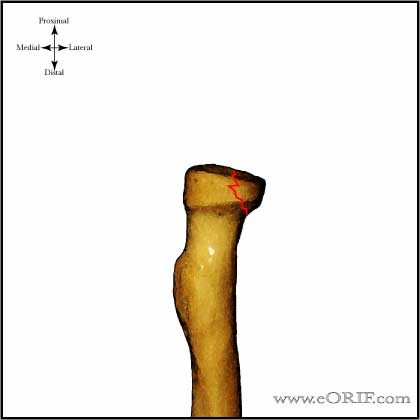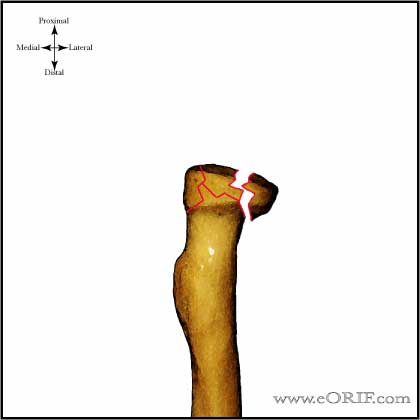 |
Type I
- <2mm displacement, or marginal lip fracture
- No mechanical block to rotation
- Treatment: Posterior splint for 1 week followed by early active range of motion.
- Consider hematoma aspiration and local anesthetic injection to fully assess ROM if evaluation is limited by pain.
- Consider static progressive nightime extension splinting if a flexion contracture is present 6 weeks after injury.
- (Liow RY, Injury 2002;33:801)
|
 |
Type II
- >2mm displacement, amendable to fixation
- May have mechanical block to motion
- Treatment: examination under anesthesia. IF mechanical block to motion, or joint instability or displacement >3mm=Radial Head Fracture ORIF; if stable, <3mm displaced with full ROM nonop treatment indicated.
- 82% of patients are asymptomatic at 19yrs with non-op treatment (Akesson T, JBJS 2006;88A:1909).
- Determination of Type II or Type III fracture type can often only be made intraoperatively.
- Have radial head replacement available.
|
 |
Type III
- Displaced, severely comminuted
- Not amendable to fixation
- Treatment: Radial Head Excision (Herbertsson P, JBJS 2004;86A:1925) vs Radial Head Replacement (Moro JK, JBJS 2001;83A:1201).
- Excision alone is contraindicated when either medial collateral ligament or interosseous membrane disruption is present. Either replacement or reconstruction is indicated in these cases.
- If distal ulnar instability is present, it is best to pin the ulna to the radius with the forearm in supination
|
 |
Type IV
- Same as type III with associated elbow dislocation.
|
|
See Also:
|
Other Classifications:
Mason Classification
- Type I=undisplaced=best prognosis. Immobilization for 1wk followed by an active ROM program beginning within 1wk to minimize long-term stiffness. (Weseley Ms, JOT 1983;23:36).
- Type II=displaced wedge fragments= best indication for surgery.
- Type III-comminuted=internal fixation should not be done in an individual older than 50 yrs, in an isolated injury, or in a fracture that is too comminuted to be fixed
AO Classification
|







